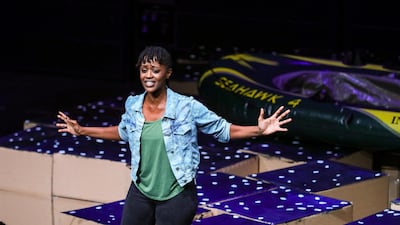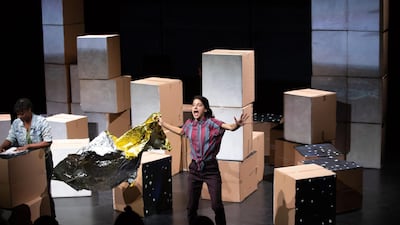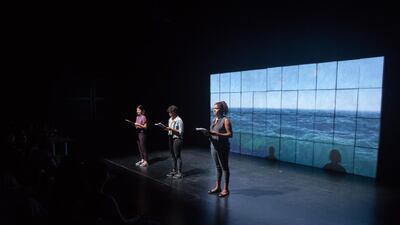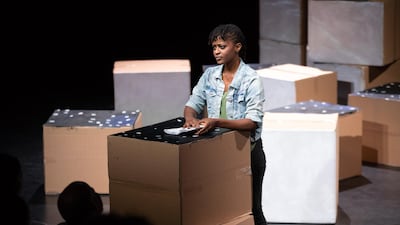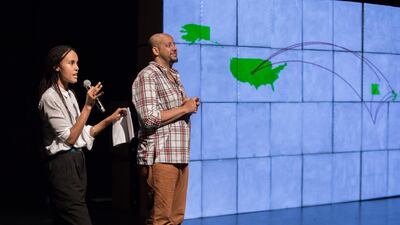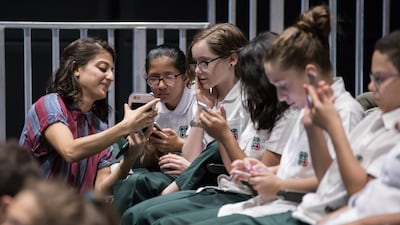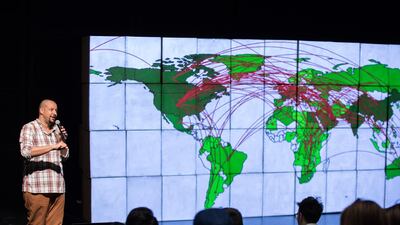“We are in the middle of one of the largest mass migrations in human history,” says Kaneza Schaal, a theatre director and performer whose play Cartography, made with Christopher Myers, was recently in rehearsals at New York University Abu Dhabi (NYUAD). “We wanted to think what tools we had as artists in this situation to make a context for young people to share stories together.”
Cartography, which premieres at the Kennedy Centre in Washington DC in January, addresses not the typical theatre-going public, but young people – many the same age as those attempting these border crossings on their own – and uses technology to draw them in.
At the recent rehearsal at NYUAD, schoolchildren from Al Raha sat neatly in attendance. For this iteration, the play was broken into two: first, a dialogue-driven performance in which three women sketched what they had fled from and their encounters along the way.
Then, secondly, the audience were asked to take out their mobile phones. The kids rustled through their backpacks and began logging into a network that was created especially for the production.
A blank screen appeared behind the performers while a map was presented on the phones. Schaal and Myers then asked the audience to trace their own journeys to Abu Dhabi and, if they wished, the countries their parents and grandparents had also moved to and from.
Zing! A couple of opening salvos were fired from the United States to the UAE. Zing! More from Europe. Whoosh! A few bounded westward from the Philippines. Some short hops came from the Levant. A few tentacles reached down to Africa. And then, as if a gate had been pushed open, a flurry of lines crossed over to Brazil, and South America revealed itself on the map. Invisible until they were activated by the audience’s journeys, soon nearly all the countries of the world appeared, until there were green continents and a tangle of routes overhead, like a pilot trailing spools of red string.
“We wanted to put these young people on a continuum,” says Myers.
“One of the myths about the refugee crisis is that it’s a new thing. This more recent alarm of the past five years ignores the fact that there have been sub-Saharan Africans migrating for many years.
“My grandfather came from Germany in 1928 on a boat and his first day in New York was spent in jail. Kaneza’s family is from Rwanda. We have so many of these refugee stories in our DNA.”
Myers and Schaal, who have collaborated before, began developing the piece after working in Munich with young refugees. Although separated by language and tradition, the children had critical experiences in common from their migrant journeys.
“There was one moment where a young woman from Syria, who was living in the same residence as someone from Nigeria, realised they had both been on inflatable rafts on the Mediterranean,” says Schaal. “There was this moment of understanding between them: you know what I am talking about.”
Cartography aims to extend this moment of understanding beyond those who are classed as refugees and out towards the audience, so many of whom have also moved and travelled, albeit under different circumstances.
“It’s such a gift to understand the world as one of migration as opposed to these hot points of tension and trauma,” says Myers. “We wanted to use theatre to create a point of contact through which people who have experienced this kind of hardship and the people who have never experienced this kind of hardship could meet and see each other.”
At NYUAD Myers and Schaal took a visible role in the rehearsal, calling out to the Raha students and joking about missteps in the process – Myers said he wanted to call the play “Why We Are Not Cats,” because cats don’t migrate – and, in a sense, to put themselves forward as role models for rethinking migration. Schaal, who directed the play, is the natural performer and has acted in the respected New York-based theatre companies The Wooster Group and the Elevator Repair Service.
Myers, who wrote the script, is a man of a unique range: he has authored award-winning children’s books, as well as plays, and is a sculptor trained on the Whitney Independent Study Programme, a crucible of critical thinking associated with the Whitney Museum of American Art in New York.
On stage, and in conversation, the pair have a beat-for-beat rhythm: neither talking over one another nor finishing each other’s sentences, they pause to reflect on what the other has to say.
The result in Cartography is a sui generis mix of high-brow allusions – to Homer’s The Odyssey, among others – and a politically inflected reconsideration of both theatre’s intended audience and its formal parameters.
Technology, for example, becomes not a gimmick but a way to echo elements of the refugee experience. The digitally rendered ocean projected behind the performers reacts to their voices: growing tumultuous as the drama of their stories intensifies, and calming down when their emotions quiet.
“Some of the kids had never seen water so big, and they had all this encounter with the ocean,” says Schaal. “It was seen as a threat and a fear, and we like the idea of inversing that and giving to their voices the ability to control the storm. The sea was a radical moment for all of these kids. They had to set their fate on the thin blue line of that horizon.”
The integration of mobile phones, too, relates to the way that phones were so important to the refugees on their journeys, helping them to navigate through the different countries they passed. And even once they arrived in their host country, Schaal notes, “they live in this hybrid world – from the WhatsApp messages they’re getting from home and the bomb shelters of their former schools, to the European job-training programmes that are on apps.”
Both the code for the ocean and the user-generated map were developed during Schaal and Myers’s NYUAD residency last month, where they worked with the university’s interactive multimedia team.
The NYUAD Arts Centre is a co-commissioner of the project, and as such, plays a key role in supporting its development. Schaal and Myers led workshops and readings, and staged this rehearsal for students and members of the NYUAD community – a typical process for the Arts Centre’s commissioning strand.
“One of the ways we describe the work of the Arts Centre is as a laboratory for performance,” explains Bill Bragin, executive artistic director of the NYUAD Arts Centre. “While most people understand the importance of research and experimentation as a process in science, most people don’t think about the parallel process that takes place in developing artistic work.”
For this play, with its subject of migration, Myers’s and Schaal’s time in Abu Dhabi was particularly helpful to the project. The pair looked beyond the NYUAD academic community to engage other ethnic groups on the subject of migration, including Filipina and Sri Lankan domestic workers as well as African-American converts to Islam, and added new stories to the research behind the project.
“Abu Dhabi is a harbinger of things to come globally around the idea of migration,” says Myers. “It has cemented our commitment to, A, understanding that communities need to be talking about this, and B, we need to understand it as a continuum.”
“I ate callaloo [a Jamaican dish] for iftar in Abu Dhabi,” says Myers. “Story told!”
Cartography premieres at the Kennedy Centre in Washington DC in January next year. For more information, see www.kennedy-center.org
_____________________
Read more:
This is 'Borderless' Japan's new digital art exhibition by teamLab
NYUAD study into sign language and brain function 'shows how similar people are'
Maritime history found in the coral walls of RAK ghost town
_____________________
A timeline of the Historical Dictionary of the Arabic Language
- 2018: Formal work begins
- November 2021: First 17 volumes launched
- November 2022: Additional 19 volumes released
- October 2023: Another 31 volumes released
- November 2024: All 127 volumes completed
Match info
Uefa Champions League Group B
Tottenham Hotspur 1 (Eriksen 80')
Inter Milan 0
Step by step
2070km to run
38 days
273,600 calories consumed
28kg of fruit
40kg of vegetables
45 pairs of running shoes
1 yoga matt
1 oxygen chamber
GAC GS8 Specs
Engine: 2.0-litre 4cyl turbo
Power: 248hp at 5,200rpm
Torque: 400Nm at 1,750-4,000rpm
Transmission: 8-speed auto
Fuel consumption: 9.1L/100km
On sale: Now
Price: From Dh149,900
COMPANY PROFILE
Name: Qyubic
Started: October 2023
Founder: Namrata Raina
Based: Dubai
Sector: E-commerce
Current number of staff: 10
Investment stage: Pre-seed
Initial investment: Undisclosed
LEADERBOARD
%3Cp%3E-19%20T%20Fleetwood%20(Eng)%3B%20-18%20R%20McIlroy%20(NI)%2C%20T%20Lawrence%20(SA)%3B%20-16%20J%20Smith%3B%20-15%20F%20Molinari%20(Ita)%3B%20-14%20Z%20Lombard%20(SA)%2C%20S%20Crocker%20(US)%3C%2Fp%3E%0A%3Cp%3E%3Cstrong%3ESelected%3A%20%3C%2Fstrong%3E-11%20A%20Meronk%20(Pol)%3B%20-10%20E%20Ferguson%20(Sco)%3B%20-8%20R%20Fox%20(NZ)%20-7%20L%20Donald%20(Eng)%3B%20-5%20T%20McKibbin%20(NI)%2C%20N%20Hoejgaard%20(Den)%3C%2Fp%3E%0A
%E2%80%98White%20Elephant%E2%80%99
%3Cp%3E%3Cstrong%3EDirector%3A%3C%2Fstrong%3E%20Jesse%20V%20Johnson%3Cbr%3E%3Cstrong%3EStars%3A%3C%2Fstrong%3E%20Michael%20Rooker%2C%20Bruce%20Willis%2C%20John%20Malkovich%2C%20Olga%20Kurylenko%3Cbr%3E%3Cstrong%3ERating%3A%3C%2Fstrong%3E%203%2F5%3C%2Fp%3E%0A
Student Of The Year 2
Director: Punit Malhotra
Stars: Tiger Shroff, Tara Sutaria, Ananya Pandey, Aditya Seal
1.5 stars
ONCE UPON A TIME IN GAZA
Starring: Nader Abd Alhay, Majd Eid, Ramzi Maqdisi
Directors: Tarzan and Arab Nasser
Rating: 4.5/5
Company: Instabug
Founded: 2013
Based: Egypt, Cairo
Sector: IT
Employees: 100
Stage: Series A
Investors: Flat6Labs, Accel, Y Combinator and angel investors
Where to buy art books in the UAE
There are a number of speciality art bookshops in the UAE.
In Dubai, The Lighthouse at Dubai Design District has a wonderfully curated selection of art and design books. Alserkal Avenue runs a pop-up shop at their A4 space, and host the art-book fair Fully Booked during Art Week in March. The Third Line, also in Alserkal Avenue, has a strong book-publishing arm and sells copies at its gallery. Kinokuniya, at Dubai Mall, has some good offerings within its broad selection, and you never know what you will find at the House of Prose in Jumeirah. Finally, all of Gulf Photo Plus’s photo books are available for sale at their show.
In Abu Dhabi, Louvre Abu Dhabi has a beautiful selection of catalogues and art books, and Magrudy’s – across the Emirates, but particularly at their NYU Abu Dhabi site – has a great selection in art, fiction and cultural theory.
In Sharjah, the Sharjah Art Museum sells catalogues and art books at its museum shop, and the Sharjah Art Foundation has a bookshop that offers reads on art, theory and cultural history.
Intercontinental Cup
Namibia v UAE Saturday Sep 16-Tuesday Sep 19
Table 1 Ireland, 89 points; 2 Afghanistan, 81; 3 Netherlands, 52; 4 Papua New Guinea, 40; 5 Hong Kong, 39; 6 Scotland, 37; 7 UAE, 27; 8 Namibia, 27
The%20specs%20
%3Cp%3E%3Cstrong%3EEngine%3A%20%3C%2Fstrong%3E2.0-litre%204cyl%20turbo%0D%3Cbr%3E%3Cstrong%3EPower%3A%20%3C%2Fstrong%3E261hp%20at%205%2C500rpm%0D%3Cbr%3E%3Cstrong%3ETorque%3A%20%3C%2Fstrong%3E400Nm%20at%201%2C750-4%2C000rpm%0D%3Cbr%3E%3Cstrong%3ETransmission%3A%20%3C%2Fstrong%3E7-speed%20dual-clutch%20auto%0D%3Cbr%3E%3Cstrong%3EFuel%20consumption%3A%20%3C%2Fstrong%3E10.5L%2F100km%0D%3Cbr%3E%3Cstrong%3EOn%20sale%3A%20%3C%2Fstrong%3ENow%0D%3Cbr%3E%3Cstrong%3EPrice%3A%20%3C%2Fstrong%3EFrom%20Dh129%2C999%20(VX%20Luxury)%3B%20from%20Dh149%2C999%20(VX%20Black%20Gold)%3C%2Fp%3E%0A
if you go
The flights
Emirates have direct flights from Dubai to Glasgow from Dh3,115. Alternatively, if you want to see a bit of Edinburgh first, then you can fly there direct with Etihad from Abu Dhabi.
The hotel
|
Located in the heart of Mackintosh's Glasgow, the Dakota Deluxe is perhaps the most refined hotel anywhere in the city. Doubles from Dh850
|
Events and tours
There are various Mackintosh specific events throughout 2018 – for more details and to see a map of his surviving designs see glasgowmackintosh.com
For walking tours focussing on the Glasgow Style, see the website of the Glasgow School of Art.
More information
For ideas on planning a trip to Scotland, visit www.visitscotland.com
Mercer, the investment consulting arm of US services company Marsh & McLennan, expects its wealth division to at least double its assets under management (AUM) in the Middle East as wealth in the region continues to grow despite economic headwinds, a company official said.
Mercer Wealth, which globally has $160 billion in AUM, plans to boost its AUM in the region to $2-$3bn in the next 2-3 years from the present $1bn, said Yasir AbuShaban, a Dubai-based principal with Mercer Wealth.
“Within the next two to three years, we are looking at reaching $2 to $3 billion as a conservative estimate and we do see an opportunity to do so,” said Mr AbuShaban.
Mercer does not directly make investments, but allocates clients’ money they have discretion to, to professional asset managers. They also provide advice to clients.
“We have buying power. We can negotiate on their (client’s) behalf with asset managers to provide them lower fees than they otherwise would have to get on their own,” he added.
Mercer Wealth’s clients include sovereign wealth funds, family offices, and insurance companies among others.
From its office in Dubai, Mercer also looks after Africa, India and Turkey, where they also see opportunity for growth.
Wealth creation in Middle East and Africa (MEA) grew 8.5 per cent to $8.1 trillion last year from $7.5tn in 2015, higher than last year’s global average of 6 per cent and the second-highest growth in a region after Asia-Pacific which grew 9.9 per cent, according to consultancy Boston Consulting Group (BCG). In the region, where wealth grew just 1.9 per cent in 2015 compared with 2014, a pickup in oil prices has helped in wealth generation.
BCG is forecasting MEA wealth will rise to $12tn by 2021, growing at an annual average of 8 per cent.
Drivers of wealth generation in the region will be split evenly between new wealth creation and growth of performance of existing assets, according to BCG.
Another general trend in the region is clients’ looking for a comprehensive approach to investing, according to Mr AbuShaban.
“Institutional investors or some of the families are seeing a slowdown in the available capital they have to invest and in that sense they are looking at optimizing the way they manage their portfolios and making sure they are not investing haphazardly and different parts of their investment are working together,” said Mr AbuShaban.
Some clients also have a higher appetite for risk, given the low interest-rate environment that does not provide enough yield for some institutional investors. These clients are keen to invest in illiquid assets, such as private equity and infrastructure.
“What we have seen is a desire for higher returns in what has been a low-return environment specifically in various fixed income or bonds,” he said.
“In this environment, we have seen a de facto increase in the risk that clients are taking in things like illiquid investments, private equity investments, infrastructure and private debt, those kind of investments were higher illiquidity results in incrementally higher returns.”
The Abu Dhabi Investment Authority, one of the largest sovereign wealth funds, said in its 2016 report that has gradually increased its exposure in direct private equity and private credit transactions, mainly in Asian markets and especially in China and India. The authority’s private equity department focused on structured equities owing to “their defensive characteristics.”
Stan%20Lee
%3Cp%3E%3Cstrong%3EDirector%3A%3C%2Fstrong%3E%20David%20Gelb%3C%2Fp%3E%0A%3Cp%3E%3Cstrong%3ERating%3A%3C%2Fstrong%3E%203%2F5%3C%2Fp%3E%0A
Yahya Al Ghassani's bio
Date of birth: April 18, 1998
Playing position: Winger
Clubs: 2015-2017 – Al Ahli Dubai; March-June 2018 – Paris FC; August – Al Wahda
UAE currency: the story behind the money in your pockets
Company%C2%A0profile
%3Cp%3E%3Cstrong%3ECompany%20name%3A%20%3C%2Fstrong%3EOutsized%0D%3Cbr%3E%3Cstrong%3EStarted%3A%20%3C%2Fstrong%3E2016%0D%3Cbr%3E%3Cstrong%3EFounders%3A%20%3C%2Fstrong%3EAzeem%20Zainulbhai%2C%20Niclas%20Thelander%2C%20Anurag%20Bhalla%20and%20Johann%20van%20Niekerk%20%0D%3Cbr%3E%3Cstrong%3EBased%3A%20%3C%2Fstrong%3EIndia%2C%20South%20Africa%2C%20South-East%20Asia%2C%20Mena%0D%3Cbr%3E%3Cstrong%3ESector%3A%3C%2Fstrong%3E%20Recruitment%0D%3Cbr%3E%3Cstrong%3EInvestment%20raised%3A%3C%2Fstrong%3E%20%241%20million%0D%3Cbr%3E%3Cstrong%3ECurrent%20staff%20count%3A%3C%2Fstrong%3E%2040%0D%3Cbr%3E%3Cstrong%3EInvestors%3A%20%3C%2Fstrong%3ESeed%20and%20angel%20investors%0D%3Cbr%3E%3C%2Fp%3E%0A
UAE rugby in numbers
5 - Year sponsorship deal between Hesco and Jebel Ali Dragons
700 - Dubai Hurricanes had more than 700 playing members last season between their mini and youth, men's and women's teams
Dh600,000 - Dubai Exiles' budget for pitch and court hire next season, for their rugby, netball and cricket teams
Dh1.8m - Dubai Hurricanes' overall budget for next season
Dh2.8m - Dubai Exiles’ overall budget for next season
End of free parking
- paid-for parking will be rolled across Abu Dhabi island on August 18
- drivers will have three working weeks leeway before fines are issued
- areas that are currently free to park - around Sheikh Zayed Bridge, Maqta Bridge, Mussaffah Bridge and the Corniche - will now require a ticket
- villa residents will need a permit to park outside their home. One vehicle is Dh800 and a second is Dh1,200.
- The penalty for failing to pay for a ticket after 10 minutes will be Dh200
- Parking on a patch of sand will incur a fine of Dh300
The 12 Syrian entities delisted by UK
Ministry of Interior
Ministry of Defence
General Intelligence Directorate
Air Force Intelligence Agency
Political Security Directorate
Syrian National Security Bureau
Military Intelligence Directorate
Army Supply Bureau
General Organisation of Radio and TV
Al Watan newspaper
Cham Press TV
Sama TV
The Details
Article 15
Produced by: Carnival Cinemas, Zee Studios
Directed by: Anubhav Sinha
Starring: Ayushmann Khurrana, Kumud Mishra, Manoj Pahwa, Sayani Gupta, Zeeshan Ayyub
Our rating: 4/5
Why seagrass matters
- Carbon sink: Seagrass sequesters carbon up to 35X faster than tropical rainforests
- Marine nursery: Crucial habitat for juvenile fish, crustations, and invertebrates
- Biodiversity: Support species like sea turtles, dugongs, and seabirds
- Coastal protection: Reduce erosion and improve water quality
Top 10 in the F1 drivers' standings
1. Sebastian Vettel, Ferrari 202 points
2. Lewis Hamilton, Mercedes-GP 188
3. Valtteri Bottas, Mercedes-GP 169
4. Daniel Ricciardo, Red Bull Racing 117
5. Kimi Raikkonen, Ferrari 116
6. Max Verstappen, Red Bull Racing 67
7. Sergio Perez, Force India 56
8. Esteban Ocon, Force India 45
9. Carlos Sainz Jr, Toro Rosso 35
10. Nico Hulkenberg, Renault 26
A State of Passion
Directors: Carol Mansour and Muna Khalidi
Stars: Dr Ghassan Abu-Sittah
Rating: 4/5
Director: Laxman Utekar
Cast: Vicky Kaushal, Akshaye Khanna, Diana Penty, Vineet Kumar Singh, Rashmika Mandanna
Rating: 1/5
